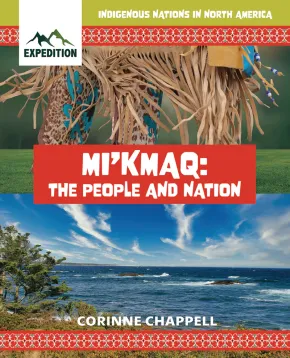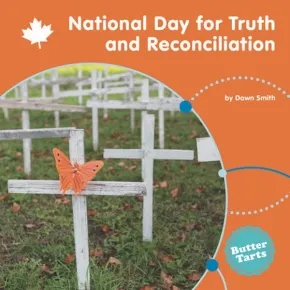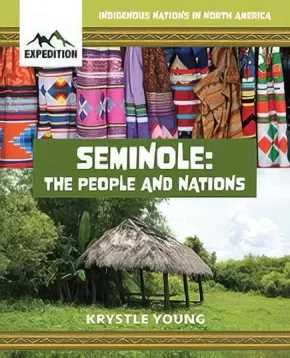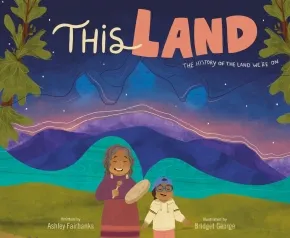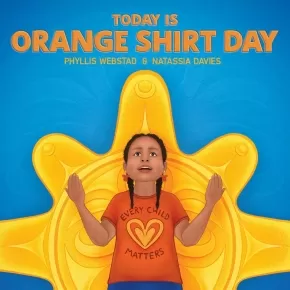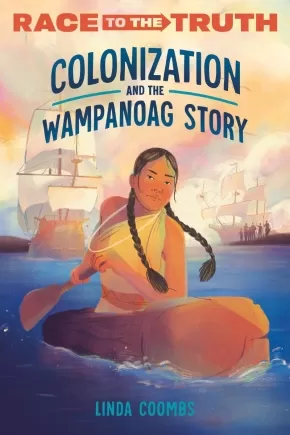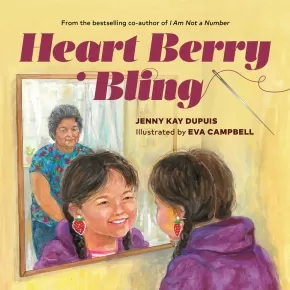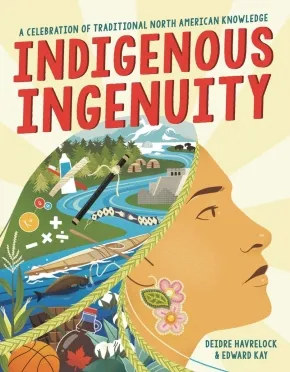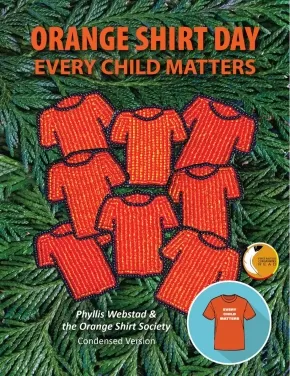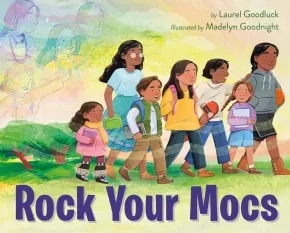
Indigenous Awareness
16
-
30
of
114 Results;
Sort By
Go To
of 8
Mi'kmaq: The People and Nation
$16.95
Format:
Paperback
Text Content Territories:
Indigenous Canadian; First Nations; Mi'kmaq (Mi'gmaq);
ISBN / Barcode: 9781774567708
Synopsis:
Synopsis:
The Mi'kmaq have many practices in their culture which make them unique. Discover more about the people and nation through Mi'kmaq author Corinne Chappell.
Educator & Series Information
This book is part of the Indigenous Nations in North America series.
Additional Information
32 Pages | Paperback
National Day for Truth and Reconciliation
$15.95
Format:
Paperback
Text Content Territories:
Indigenous Canadian; First Nations; Nuu-chah-nulth (Nootka);
ISBN / Barcode: 9781774564950
Synopsis:
Synopsis:
Readers are invited to jump into a canoe to learn about residential schools in Canada and the special day for truth and reconciliation. Author Dawn Sii-yaa-ilth-supt Smith is Nuu-chah-nulth and attended Tsartlip Indian Day School in British Columbia. She shares her story and the importance of truth-telling and reconciliation in Canada.
Educator & Series Information
Juvenile Nonfiction
This book is part of the Indigenous Communities in Canada series.
This book is available in French: La Journee nationale de la verite et de la reconciliation
Additional Information
24 Pages
Seminole: The People and Nations
$16.95
Format:
Paperback
Text Content Territories:
Indigenous American; Native American; Seminole;
ISBN / Barcode: 9781774565148
Synopsis:
Synopsis:
Orginating from Florida, the Seminole nation has a deep history in North America. Discover more about the Seminole nation, their traditions and story.
Educator & Series Information
This book is part of the Indigenous Nations in North America series.
Additional Information
32 Pages | Paperback
This Land: The History of the Land We're On
$24.99
Format:
Hardcover
Text Content Territories:
Indigenous American; Native American; Anishinaabeg;
ISBN / Barcode: 9780593651445
Synopsis:Lexile measure: AD630L
Synopsis:
This land is your land now, but who did it belong to before? This engaging primer about native lands invites kids to trace history and explore their communities.
Before my family lived in this house, a different family did, and before them, another family, and another before them. And before that, the family who that lived here lived not in a house, but a wigwam. Who lived where you are before you got there?
This Land teaches readers that American land, from our backyards to our schools to Disney World, are the traditional homelands of many Indigenous nations. This Land will spark curiosity and encourage readers to explore the history of the places they live and the people who have lived there throughout time and today.
Reviews
"This work aptly communicates the issue of land acknowledgments . . . A memorable message." —Publishers Weekly, starred review
"A stirring tale that fosters respect for Native peoples." —Kirkus Reviews
Educator Information
Recommended for ages 4 to 8.
Fountas & Pinnell Text Level Gradient: M
Additional Information
40 pages | 11.37" x 9.37" | Hardcover
Today is Orange Shirt Day (BB)
$13.95
Artists:
Format:
Board Book
Text Content Territories:
Indigenous Canadian; First Nations; Salish; Interior Salish; Secwepemc (Shuswap); Stswecem'c Xgat'tem;
Grade Levels: Preschool;
ISBN / Barcode: 9781778540363
Synopsis:
Synopsis:
Today, we gather together Today, we listen Today, we learn Today, we open our hearts
A first conversation about the importance of Orange Shirt Day - Every Child Matters and what little ones can expect to see and do on Orange Shirt Day - The National Day for Truth and Reconciliation.
An authentic, age-appropriate touch-and-feel board book designed for ages 0-3, written by the founder of the Orange Shirt Day movement and author of award-winning picture book Every Child Matters.
Orange Shirt Day is a day recognized annually on September 30th to honour Residential School Survivors, their families, and the children who did not come home.
Awards
- Silver IPPA Book Award Winner (First Nations/Indigenous Communities category)
Educator Information
Recommended for ages 0 to 3.
This book is available in French: La Journée du chandail orange, c'est aujourd'hui (BB)
Additional Information
24 pages | 7.00" x 7.00" | Board book
Colonization and the Wampanoag Story
$11.99
Format:
Paperback
Text Content Territories:
Indigenous American; Native American; Wampanoag (Wôpanâak);
ISBN / Barcode: 9780593480434
Synopsis:
Synopsis:
Until now, you've only heard one side of the story: the "discovery" of America told by Christopher Columbus, the Pilgrims, and the Colonists. Here's the true story of America from the Indigenous perspective.
When you think about the beginning of the American story, what comes to mind? Three ships in 1492, or perhaps buckled hats and shoes stepping off of the Mayflower, ready to start a new country. But the truth is, Christopher Columbus, the Pilgrims, and the Colonists didn't arrive to a vast, empty land ready to be developed. They arrived to find people and communities living in harmony with the land they had inhabited for thousands of years, and they quickly disrupted everything they saw.
From its "discovery" by Europeans to the first Thanksgiving, the story of America's earliest days has been carefully misrepresented. Told from the perspective of the New England Indigenous Nations that these outsiders found when they arrived, this is the true story of how America as we know it today began.
Reviews
"A poignant and powerful look at identity, change, and resiliency." —Kirkus Reviews
Educator Information
Recommended for ages 10+.
Additional Information
272 pages | 5.50" x 8.31" | Paperback
Haywaas' Question: What Is Reconciliation?
$16.95
Format:
Paperback
Text Content Territories:
Indigenous Canadian; First Nations; Haida;
ISBN / Barcode: 9781738736706
Synopsis:
Synopsis:
After Haywaas sees his parents get frustrated while watching the news, this precocious 12-year-old begins a months-long journey navigating many different answers to what he thought was a simple question.
Expertly crafted by a teacher-parent-author duo, Haywaas’ Question is relatable, understandable, and aptly builds up to an answer we’re all a part of.
Educator Information
The publisher recommends this picture book for Grades 4 - 10.
This book is available in French: La Question de Haywaas: Qu'est-ce que la réconciliation?
Additional Information
36 pages | 7.00" x 9.00" | Paperback
Heart Berry Bling
$24.95
Artists:
Format:
Hardcover
Text Content Territories:
Indigenous Canadian; First Nations; Anishinaabeg;
ISBN / Barcode: 9781774920558
Synopsis:
Synopsis:
On a visit to her granny, Maggie is excited to begin her first-ever beading project: a pair of strawberry earrings. However, beading is much harder than she expected! As they work side by side, Granny shares how beading helped her persevere and stay connected to her Anishinaabe culture when she lost her Indian status, forcing her out of her home community—all because she married someone without status, something the men of her community could do freely.
As she learns about patience and perseverance from her granny’s teachings, Maggie discovers that beading is a journey, and like every journey, it’s easier with a loved one at her side.
In this beautifully illustrated book, children learn about the tradition of Anishinaabe beadwork, strawberry teachings, and gender discrimination in the Indian Act.
Reviews
"Social justice messages lie at the heart of many children’s and YA books with Indigenous authorship. The picture book Heart Berry Bling, written by Jenny Kay Dupuis, a member of the Nipissing First Nation, and illustrated by Ghana-born artist Eva Campbell, shares the tradition of Anishinaabe beadwork and highlights the experiences of women, including the author’s grandmother, who lost their First Nations status due to Canada’s Indian Act."— Publishers Weekly
"A delightful story."— Anishnabek News
"Heart Berry Bling is a soulful children’s story that reminds readers of not only the importance of family and culture, but also the generational harm caused by laws against Indigenous Peoples. In this tale of a young Anishinaabe girl who finds out how her own family was negatively impacted by the Indian Act, Jenny Kay Dupuis has created an important text for anyone learning of the erased ancestral stories from and about Indigenous Peoples." — John P. Broome, Purdue University
Educator Information
Recommended for ages 6 to 8.
Additional Information
48 pages | 9.00" x 9.00" | Hardcover
Indigenous Ingenuity: A Celebration of Traditional North American Knowledge (PB)
$12.99
Artists:
Format:
Paperback
ISBN / Barcode: 9780316413435
Synopsis:
Synopsis:
Celebrate Indigenous thinkers and inventions with this beautifully designed, award-winning interactive nonfiction book—perfect for fans of Braiding Sweetgrass.
Corn. Chocolate. Fishing hooks. Boats that float. Insulated double-walled construction. Recorded history and folklore. Life-saving disinfectant. Forest fire management. Our lives would be unrecognizable without these, and countless other, scientific discoveries and technological inventions from Indigenous North Americans.
Spanning topics from transportation to civil engineering, hunting technologies, astronomy, brain surgery, architecture, and agriculture, Indigenous Ingenuity is a wide-ranging STEM offering that answers the call for Indigenous nonfiction by reappropriating hidden history. The book includes fun, simple activities and experiments that kids can do to better understand and enjoy the principles used by Indigenous inventors. Readers of all ages are invited to celebrate traditional North American Indigenous innovation, and to embrace the mindset of reciprocity, environmental responsibility, and the interconnectedness of all life.
Reviews
"An astonishing, exuberant treasure trove of history, science and hands-on activities that repeatedly begs the question: "Why didn't I know this?" Essential for kids and adults. We need this book." —Candace Fleming, award-winning author of The Rise and Fall of Charles Lindbergh and The Family Romanov
"This book will amaze readers and teachers as it demonstrates how pervasive and critical the history of Indigenous people is. A completely unique and important narrative not to be missed; readers and teachers will come away with a new appreciation for the myriad contributions Indigenous people have made."—SLJ, starred review
"A conversational tone invites readers to engage with this monumental collection . . . Curious readers will learn facts unique to individual tribal groups while gaining knowledge of STEM/STEAM concepts. An ambitious, appealing, and accessible work documenting and protecting valuable knowledge."—Kirkus Reviews
"Engaging and informative, this will be welcomed by both STEM and social studies curricula to help to correct prevailing narratives about Indigenous technology."—Booklist, starred review
"Via authoritative, meticulously researched prose, the creators detail Native peoples’ significant strides in scientific pursuits . . . [and] showcase Native tribes’ continual and enduring impact. Photographs, as well as interactive activities detailing recipes and science experiments, feature throughout, lending a hands-on approach to this clear and concise work."—Publishers Weekly
"This book is a valuable contribution to efforts to decolonize learning and introduce readers to the breadth of indigenous knowledge as practiced in widely disparate geographic zones."—Canadian Review of Materials
"An engaging and cleverly compiled guide to North American and Mesoamerican Indigenous innovation. STEM topics (housing, medicine, clothing, agriculture, and hunting among them) are compellingly and conversationally discussed."—Shelf Awareness
Educator Information
Recommended for ages 8 to 12.
Fountas & Pinnell Text Level Gradient: Z
Additional Information
288 pages | 6.95" x 9.00" | Paperback
Nutshimit: In the Woods
$22.99
Artists:
Format:
Hardcover
Text Content Territories:
Indigenous Canadian; First Nations; Innu (Montagnais-Naskapi); Ekuanitshit; Inuit; Métis;
ISBN / Barcode: 9781039701809
Synopsis:
Synopsis:
In this immersive first-person account, Innu author Melissa Mollen Dupuis teams up with award-winning author and illustrator Elise Gravel to take readers on a journey through Innu culture, from creation legends to life today.
The Innu word Nutshimit signifies the physical and social space to practice traditional activities and language. Join author Melissa Mollen Dupuis on a guided walk deep through the forest to learn some of the rich culture of the Innu people.
Readers will discover the importance of natural world and learn a few Innu words along the way. Thoughtfully brought to life by Elise Gravel’s signature comic style illustrations, Melissa’s colloquial narrative and anecdotes detailing her lived experiences offer a deeply personal look at Innu life.
Educator Information
Recommended for ages 6 to 8.
Children learn Innu nature vocabulary through anecdotes from author’s lived experiences.
Populated with Elise Gravel’s hilarious characters and plenty of fun details.
This book is available in French: Nutshimit: Un bain de forêt
Find an activity book for this title here: Nutshimit: Activity Book
Additional Information
88 pages | 8.00" x 11.00" | Hardcover
Orange Shirt Day: Every Child Matters: Condensed Edition
$19.99
Format:
Paperback
Text Content Territories:
Indigenous Canadian; First Nations; Inuit; Métis;
ISBN / Barcode: 9781778540158
Synopsis:
Synopsis:
A special abridged version of the award-winning book Orange Shirt Day: September 30th.
Orange Shirt Day, observed annually on September 30th, is also known as the National Day for Truth and Reconciliation. It is an official day to honour Residential School Survivors and their families, and to remember the children who did not come home. What was initially envisioned as a way to keep the conversations going about all aspects of Residential Schools in Williams Lake and the Cariboo Region of British Columbia, Canada, has now expanded into a movement across Turtle Island and beyond.
Orange Shirt Day: Every Child Matters aims to create champions who will walk a path of reconciliation and promote the message that 'Every Child Matters'. This version also explores a number of important topics including the historical, generational, and continual impacts of Residential Schools on Indigenous Peoples, the journey of the Orange Shirt Day movement, and how you can effectively participate in the National Day for Truth and Reconciliation. With end-of-chapter reflection questions and a series of student art submissions, readers are guided to explore how they, and others, view and participate in Residential School reconciliation.
Educator Information
Recommended for Young Adults (ages 10+)
This is an abridged version (condensed version) of Orange Shirt Day: September 30th.
This book is available in French: La journee du chandail orange: Chaque enfant compte
Additional Information
108 pages | 8.50" x 11.00" | Paperback
Orange Shirt Day: September 30th: Revised Edition
$32.99
Format:
Hardcover
Text Content Territories:
Indigenous Canadian; First Nations; Inuit; Métis;
ISBN / Barcode: 9781778540141
Synopsis:
Synopsis:
Orange Shirt Day, observed annually on September 30th, is also known as the National Day for Truth and Reconciliation. It is an official day to honour Residential School Survivors and their families, and to remember the children who did not come home. What was initially envisioned as a way to keep the conversations going about all aspects of Residential Schools in Williams Lake and the Cariboo Region of British Columbia, Canada, has now expanded into a movement across Turtle Island and beyond. Orange Shirt Day: September 30th aims to create champions who will walk a path of reconciliation and promote the message that 'Every Child Matters'. This award-winning book explores a number of important topics including the historical, generational, and continual impacts of Residential Schools on Indigenous Peoples, the journey of the Orange Shirt Day movement, and how you can effectively participate in the National Day for Truth and Reconciliation. With end of chapter reflection questions and a series of student art submissions, readers are guided to explore how they, and others, view and participate in Residential School reconciliation.
Awards
- 2021 First Nation Communities Read 2021 Winner
Educator Information
Recommended Ages: 10+
Orange Shirt Day was inspired by the story of a survivor named Phyllis Webstad. When Phyllis was 6 years old she went to residential school for the first time wearing a brand new shiny orange shirt. When she arrived at the school her shirt was taken away and never to be seen again. To Phyllis the colour orange was a symbol that she did not matter. Today she has learned to accept the colour and even have fun with it and now the orange shirt has become a symbol of hope and reconciliation. By wearing an orange shirt on Orange Shirt Day, you make a powerful statement that residential schools were wrong and commit to the concept that EVERY CHILD MATTERS.
The Orange Shirt Society is a non-profit organization with its home in Williams Lake, BC where Orange Shirt Day began in 2013. The society has both Indigenous and non-Indigenous board members, and one of the editors of this book, Phyllis Webstad, is Indigenous. Therefore, the Authentic Indigenous Text label has been applied. It is up to readers to determine if this book is authentic for their purposes.
This is the Revised 2023, 2nd Edition
Additional Information
156 pages | 8.23" x 11.06" | Revised, 2nd Edition
Powwow Dancing With Family (PB)
 $16.95
$16.95

Artists:
Format:
Paperback
Text Content Territories:
Indigenous Canadian; First Nations; Salish; Interior Salish; Secwepemc (Shuswap);
ISBN / Barcode: 9781771746281
Synopsis:
Synopsis:
Drumming, singing, and dancing are all part of being at a Powwow. Perry and his family travel all over North America to participate in these family and community gatherings. Join Perry’s two boys as they share their treasured memories of being at Powwows with their family and learning how to dance.
Reviews
“Lavishly illustrated with photographs, vivid sketches, and ledger art, Powwow Dancing With Family provides a detailed description of each stage of the Powwow, historical and contemporary aspects of the Powwow, and pays homage to Indigenous culture and customs. This informative resource will support studies of Indigenous culture, history, traditions, community, art, and family lifestyle.” – ERAC Review, May 2019
Educator Information
Includes three pages of educational material on Powwows with information found under these headings:
- What is a Powwow?
- Powwow Regalia
- Powwow Dances
About Perry Smith's Ledger Art:
Ledger Art is an art form that was developed in the mid 1800s to early 1900s by the Plains First Nations during a time when reserves were being established across North America. The ledger books were acquired in trade, war, or raids. New art supplies were also introduced: coloured pencils, crayons, and occasionally water paints. The new supplies were favoured by artists over the traditional bone and stick brushes. Many of the artworks within these ledger books display a traditional way of life, before assimilation. Today these artworks are greatly valued for the historical perspective that they offer.
Additional Information
32 pages | 8" x 8" | ISBN: 9781771746281 | Paperback
Rock Your Mocs
$24.99
Artists:
Format:
Hardcover
Text Content Territories:
Indigenous American; Indigenous Canadian;
ISBN / Barcode: 9780063099890
Synopsis:
Synopsis:
In this happy, vibrant tribute to Rock Your Mocs Day, observed yearly on November 15, author Laurel Goodluck (Mandan, Hidatsa, and Tsimshian) and artist Madelyn Goodnight (Chickasaw) celebrate the joy and power of wearing moccasins—and the Native pride that comes with them. A perfect book for Native American Heritage Month, and all year round!
We’re stepping out
and kicking it up.
Wearing beauty on their feet—
as art, as tradition,
with style, with pride—
kids from different Native Nations know
every day is a day to ROCK YOUR MOCS!
This book contains an author’s note with additional information about moccasins and Rock Your Mocs day, for readers curious to learn more about intertribal pride and the joy found in different Native identities! Rock Your Mocs Day has now been extended to a week in November, and during that week, kids from all over the United States and North America join together to show pride in their heritage.
Educator Information
Recommended for ages 4 to 8.
Additional Information
32 pages | 10.00" x 8.00" | Hardcover
Stand as Tall as the Trees: How an Amazonian Community Protected the Rain Forest
$21.99
Artists:
Format:
Hardcover
Text Content Territories:
Indigenous South American; Indigenous Peoples in Ecuador; Kichwa (Quichua);
ISBN / Barcode: 9781623542368
Synopsis:
Synopsis:
An inspiring true story about how an activist in the Amazon worked with other Indigenous communities to protect and preserve their sacred lands and forests.
Patricia (Paty) Gualinga grew up in her Kichwa village in the Amazon of Ecuador where mystical beings called Amazanga help protect the forest. Paty traveled away from home for school until she was called back—companies that said the government sold them property were destroying her people’s lands to look for oil. The Kichwa community worked with other Indigenous groups to bring the Ecuadorian government to the Court of Human Rights.
Lyrically told and beautifully illustrated, this moving story will remind readers of the importance of nature conservation, perseverance, and standing up for your community.
Educator Information
Recommended for ages 6 to 9.
Additional Information
40 pages | 7.87" x 11.00" | Hardcover
Sort By
Go To
of 8

